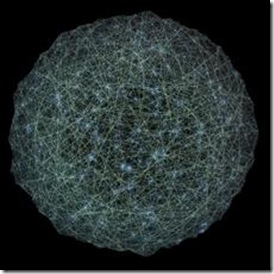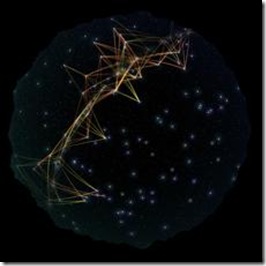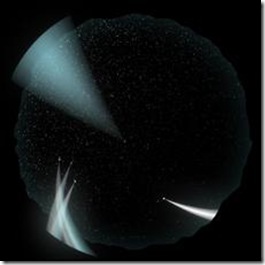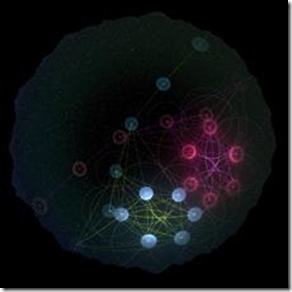 Image 1: Low Earth-orbiting Satellites
Image 1: Low Earth-orbiting Satellites
INTRODUCTION
The mechanical chaos above our heads affects us directly in an astounding array of ways. The technologies we take for granted, as banal as the GPS in our cars and our mobile phones, are nearly all airborne. Our communications, our media, our military, our science, our security, and our safety are all tied to mechanical superstructures drifting silently above us. Although we can’t see them or touch them, they too are part of what N. Katherine Hayles describes as the post-human tendency to physically extend ourselves through technology.
AERIAL MACHINES AND EVERYDAY LIFE
However, constant use does not equal constant awareness…we use these technologies without being directly conscious of them. In his introduction to Gene Youngblood’s Expanded Cinema, Buckminster Fuller explains that “thus has man been advantaged by the few who have thought and acted to produce the instruments, as yet relieving the vast majority of humans from the necessity of having to think and coordinate their sensings with the realities of cosmic mechanics” (p. 24). However, there are dangers to being ‘relieved from the necessity of thinking’. Celestial hardware is completely changing our experience with our world and each other, yet doing it invisibly, silently. To quote Fuller again, “The most important part about tomorrow is not the technology or the automation, but that man is going to come into entirely new relationships with his fellow men” (p. 45). One such relationship is invisible mediation.
THE PROBLEMATICS OF SCALE
The problem of visualizing emergent systems has been increasingly considered by both theorists and designers. Designer Bruce Mau recognizes the difficulties with displaying “quantities on a scale the world had never seen.” (Maclear & Testa, 2000, p. 497) Mau feels the core 21st century design problem relates to growth. “I increasingly believe that the future of design rests in our ability and willingness to develop new practices and theories of form that are inextricably linked to, and informed by, life and growth. “ (Maclear & Testa, 2000, p. 499). The lack of effective design tools to display complex, mutating data is a unique problem for the new millennium.
The mix of delicate tracking technologies and our expanding computing power suddenly allows us to consider massive amounts of data over vast terrains like this. However, the volume, complexity, and volatility of the statistics make traditional display difficult. On his homepage, MIT’s Ben Fry explains that “there is a space of highly complex systems for which we lack deep understanding because few techniques exist for visualization of data whose structure and content are undergoing continuous change.” (Fry, 2005)
PLANETARIUMS RECONSIDERED
This particular scientific visualization problem is not new. Planetariums recreate nature for closer study. Although they are often dismissed as a 1960’s fad, their mission to recreate the awe in their scientific data is valid. “Celestial Mechanics” hopes to help reinvent the planetarium as a creative, perceptual, and cognitive environment and offer a new way to experience the emergent system of technologies operating above us. The project investigates the use of planetariums as an alternative form of information display by creating a ‘night sky’ program that, instead of showing stars and planets, shows the various strata of man-made technologies in the sky. The architectural dome display surface is particularly well-suited for the complexity of understanding air traffic.
DATA COLLECTION ON THE TECHNOLOGICAL SKY
Data was researched via the web and through interaction with government and scientific agencies. Actual path data for satellites was retrieved from the SSR Report, a public domain document supplied by NASA. Airplane path data was collected from the Federal Aviation Administration who provided longitude, latitude, and altitude for every commercial plane both airborne and grounded, every three minutes, over 12 hours. Weather balloon data was collected via the National Oceanic and Atmospheric Administration who supplied worldwide launch sites and times. ‘Non-path’ aerial technologies (balloons, helicopters, model rockets) were collected as protocols. ABC News, Los Angeles Sheriffs Department, Los Angeles Police Department, Los Angeles Fire Department, US Coast Guard, private charter companies, and private medical transport companies were contacted and interviewed regarding steps of action during specific events. Model Rocketry data was researched via user groups and the web.
 Image 3: Communication Satellites and the GeoStationary Ring
Image 3: Communication Satellites and the GeoStationary Ring
A total of 46 different technologies were researched and incorporated into the script. Eight different technologies were selected for the prototype presentation, based on their potential for visual representation and as a cross section of each altitude level. As the project evolved, it was clear that entropy was built into its design. Within weeks after the artwork had shifted from research to design, new technologies were introduced into the sky. “Celestial Mechanics” is a snapshot of the airborne hardware at one moment in man’s history and is almost immediately a historical artifact.
PRODUCTION
Once compiled, the data was parsed into MEL, a scripting language used by the 3D animation program Maya or parsed through the programming language Processing. A virtual dome was created that comprised of a 5-camera rig—looking north, south, east, west, and directly up. A team of animators in Design|Media Arts at UCLA each tackled a different data set, with the artists overseeing the design and making adjustments for aesthetic choices—speeding things up, changing point-of-view, etc. “Celestial Mechanics” was not meant as a scientific tool but an artwork, and creative license was taken to increase the power and emotion of overall piece.
The animations were rendered and then, using a proprietary software courtesy of Evans and Sutherland, the five camera views were ‘stitched’ together into round dome originals. Skywalker Sound, having read about the project online, volunteered to create the sound design for the project. The resulting artwork premiered concurrently in portable domes at UCLA and Siggraph in Los Angeles in the summer of 2005.
CONCERNS ABOUT EMERGENCE AND CHAOS
The systems above require great cultural, economic, and political coordination yet there seems to be no singular control. The statistics for “Celestial Mechanics”—air traffic paths, satellite movement, weather hardware trajectories, helicopter protocols—came in separately, in exclusive datasets that eerily ignored the other competing systems that were in the sky. The most complete tracking is done by NASA which disseminates some of the data, conceals some, and ignores some. However, tracking these systems is very different than controlling them. Even the frequent launches of communication satellites are ‘guessed’ to avoid the thousands of space debris fragments. Collisions have occurred, but the sky is still treated with the same cavalier attitude of the American west in the 1800s…the celestial real estate is too big an expanse to worry about congestion yet.
Once the technologies were plotted, relationships became visible that were never shown in the individual datasets. Technologies are adjusting in relation to other technologies, systems are resetting paths, applications are reinventing themselves, machines are decaying in manners never predicted. The hardware and software in the sky are demonstrating behaviors that were never coded into their original design. The complex generation of patterns and chaos above is symptomatic of some flavor of emergent system. Partially human-controlled, it is a human/emergent hybrid, a gradient system that is evolving both by human interaction and its own intelligence.
MACHINES, MEDIA, MYTHOLOGY, AND METAPHOR
“Celestial Mechanics” shows a dynamic system of independent yet interacting parts to visualize the aesthetics of emergence as a collage. Using the technology, architecture, and media experience of the planetarium, the piece attempts to investigate the cultural meaning attached to the machines above us…and find the emotional and social meaning as well. By seeing relationships evolve above us, it becomes an emerging cultural mythology.
Many of the machine behaviors and patterns in the artwork are already part of our semiotic language. The shaky blue circle of light from a police helicopter is as culturally coded as the military planes flying in perfect V formation, the stacked planes over LAX, and the melancholy dissipation of distant jet trails. Just like the mythologies created centuries ago by seeing patterns in the stars, we again are applying cultural significance to pattern and new ‘constellations’ are being formed by airborne machinery.
 Image 4: Los Angeles Police Helicopters
Image 4: Los Angeles Police Helicopters
Technology is generating a mythology. “We’re developing all these fabulous hardware systems that soon will make life a process of continual myth-generation for the individual as well as the collective ego” (Youngblood, 1970, pg. 349). By applying the patterns, cycles, and trails of aerial technologies in such a radically different context, the planetarium has allowed us to both create and find new meaning in the data.
References:
Fuller, R. Buckminster (1970). Expanded Cinema (Introduction). New York: E.P. Dutton and Co.
Fry, Ben. (2005) From his homepage. Retrieved January 29, 2005 from http://www.benfry.com,
Maclear, K., & Testa, B. (Eds.). (2000). Life Style: Bruce Mau London: Phaidon
Youngblood, Gene (1970). Expanded Cinema. New York: E.P. Dutton and Co.

Leave a comment